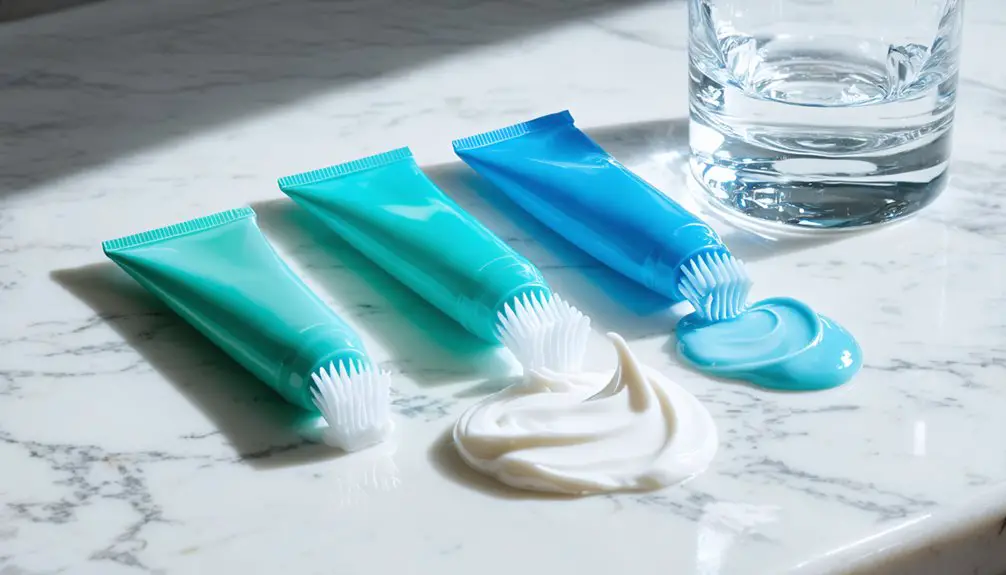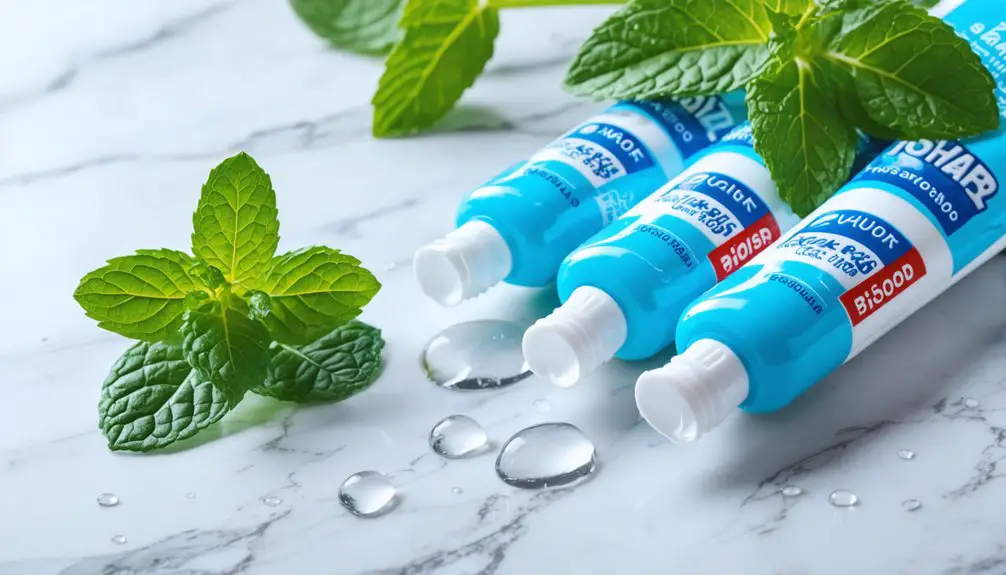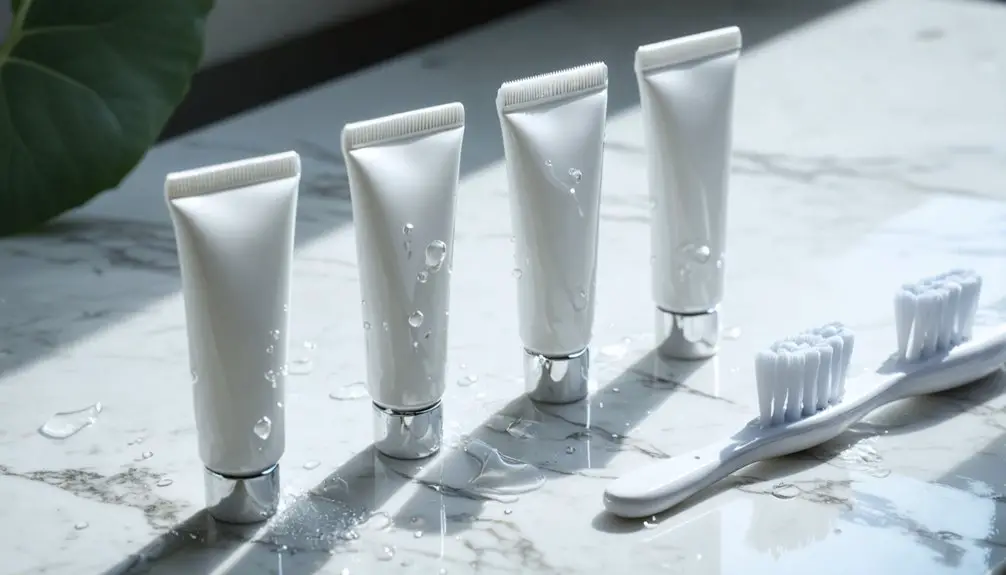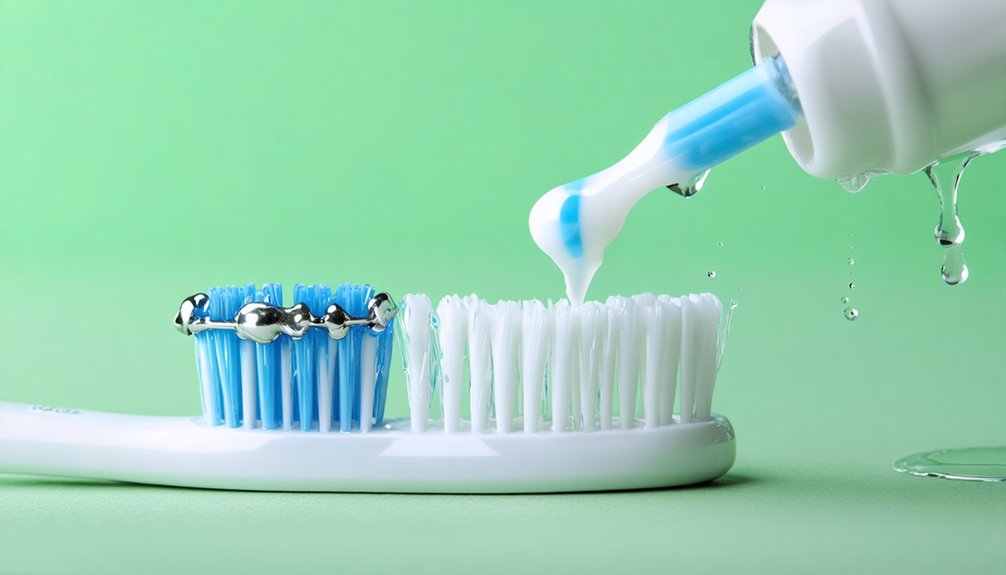For stubborn tooth stains, you’ll find maximum effectiveness with professional-grade whitening formulas containing 4% hydrogen peroxide, like Crest 3D White Brilliance Pro Ultra White and Colgate Optic White Advanced. These toothpastes combine powerful peroxide agents with specialized abrasives to lift surface stains while protecting enamel. While results appear gradually over several weeks, you can enhance your whitening success by understanding key ingredients and proper application techniques.
Key Takeaways
- Crest 3D White Brilliance Pro Ultra White contains 4% hydrogen peroxide, making it highly effective for deep-set stains.
- Professional-grade whitening toothpastes combine peroxide agents with gentle abrasives for maximum stain removal without damaging enamel.
- Colgate Optic White Advanced features advanced whitening technology and fluoride protection for tough stains and enamel care.
- Toothpastes with both chemical agents and mild abrasives provide dual-action stain fighting for optimal results.
- Look for formulas containing hydrated silica, calcium carbonate, and hydrogen peroxide for comprehensive stain removal.
What Makes a Great Stain-Fighting Toothpaste
When evaluating stain-fighting toothpaste, the combination of abrasive components and chemical agents determines its effectiveness at removing stubborn discoloration.
You’ll want to look for formulations containing mild abrasive ingredients like hydrated silica, calcium carbonate, or baking soda, which physically lift surface stains without damaging enamel.
The most effective stain removal comes from products that pair these abrasives with chemical agents like hydrogen peroxide or carbamide peroxide.
Combining abrasive ingredients with peroxide-based agents creates a powerful dual-action approach for removing tough tooth stains effectively.
These compounds break down stains chemically while protective ingredients like sodium hexametaphosphate create barriers against new staining.
Results typically become visible after gradual use over several weeks of consistent brushing.
Clinical trials show that well-formulated toothpastes can remove up to 80-100% of extrinsic stains when used properly. Studies indicate that only a few toothpastes actually demonstrate significant chemical stain removal capabilities.
However, it’s essential to choose products with balanced abrasive levels to prevent enamel wear and sensitivity while maintaining ideal cleaning power.
Best Professional-Grade Whitening Formulas
Professional-grade whitening formulas represent the pinnacle of stain-fighting technology, combining powerful peroxide agents with advanced abrasive systems.
Leading products like Crest 3D White Brilliance Pro Ultra White, with 4% hydrogen peroxide, and Colgate Optic White Advanced, featuring 2% hydrogen peroxide, demonstrate significant whitening technology advancements. The Brilliance Pro Ultra White delivers clinically proven whitening while maintaining complete enamel safety.
Your enamel protection strategies are enhanced through multi-ingredient systems that pair whitening agents with fluoride and sensitivity-reducing compounds. Regular use of these products can yield gradual improvement in tooth brightness.
These formulations incorporate enzymatic stain fighters like bromelain and papain, working alongside calibrated abrasives for ideal results.
For maximum effectiveness, you’ll find professional-grade options now include LED-enhanced systems and targeted application pens containing up to 6% hydrogen peroxide.
These ADA-approved products deliver dentist-grade results while maintaining strict enamel safety standards.
Natural Vs Chemical Whitening Options
Choosing between natural and chemical whitening toothpaste presents distinct trade-offs in efficacy, safety, and environmental impact.
Chemical agents like hydrogen peroxide deliver faster, more noticeable results for stubborn stains, while natural ingredients offer gentler whitening with fewer side effects.
While peroxide-based whiteners tackle tough stains quickly, natural whitening ingredients provide a milder approach with reduced sensitivity risk.
- Chemical formulations demonstrate superior whitening power through combined peroxide and abrasive action.
- Natural options contain plant-based ingredients like coconut oil and essential oils that safely remove surface stains.
- Chemical agents may cause sensitivity and enamel wear with prolonged use.
- Natural ingredients prioritize sustainability and eco-friendly packaging.
Natural formulations incorporating bicarb soda provide effective stain removal while maintaining gentle cleansing action.
Professional treatments using in-office bleaching can deliver immediate whitening results for those seeking faster outcomes.
When recommending options to your clients, consider their specific needs.
Those with sensitive teeth or chemical concerns may benefit from natural formulations, while patients seeking dramatic results might prefer professional-grade chemical whiteners.
Always weigh the documented efficacy against potential risks and environmental impact.
Protecting Sensitive Teeth While Whitening
Although whitening treatments can transform your smile, protecting sensitive teeth during the process requires careful consideration of product formulations and application methods.
Products containing active peroxide ingredients can penetrate the enamel and cause temporary tooth discomfort.
If you’re helping patients with tooth sensitivity, recommend toothpastes containing desensitizing ingredients like potassium nitrate and nano-hydroxyapatite, which reduce nerve response while whitening.
Focus on products with low Relative Dentin Abrasion scores to prevent further enamel damage. Promote enamel remineralization by selecting formulas that incorporate mineral-rebuilding agents.
For best results, guide patients toward gradual whitening approaches using gentle formulations specifically designed for sensitive teeth. Clinical studies show that Sensodyne Clinical White can whiten teeth by up to two shades within two weeks. Professional treatments can be customized to minimize discomfort by controlling whitening agent concentration and exposure time.
Avoid recommending high-concentration peroxide products or multi-session bleaching treatments, which may intensify sensitivity.
Daily Care Tips for Maintaining White Teeth
Maintaining a bright, white smile requires consistent daily care habits that prevent new stains while preserving previous whitening results. Your dental hygiene routine should integrate evidence-based practices that protect enamel integrity while maximizing stain prevention.
A radiant smile depends on daily habits that protect teeth from staining while safeguarding the results of previous whitening treatments.
Consider incorporating crunchy fruits and vegetables like apples and carrots into your diet, as these foods naturally help clean teeth surfaces while you eat.
Practice strategic hydration habits by drinking water after consuming staining beverages, and wait 30 minutes before brushing after acidic foods.
Use a soft-bristled brush with fluoride whitening toothpaste twice daily, applying gentle pressure to avoid enamel abrasion. Trying oil pulling techniques can complement your oral care routine by helping remove toxins and bacteria that contribute to discoloration.
Incorporate sugar-free gum between meals to stimulate saliva production, which naturally cleanses teeth and neutralizes harmful acids that contribute to staining.
Professional guidance suggests combining these practices with regular dental visits for ideal whitening maintenance.
Frequently Asked Questions
How Long Should I Wait After Eating Before Using Whitening Toothpaste?
For ideal whitening toothpaste effectiveness, you’ll want to wait 30 minutes after eating before brushing. This dental hygiene practice allows your enamel to re-harden and prevents potential abrasion damage.
Can Whitening Toothpaste Remove Years-Old Tobacco or Medication Stains?
While whitening toothpaste can remove up to 80% of surface stains, you’ll need professional treatment for years-old tobacco stains and medication discoloration, as they’re typically embedded too deeply for toothpaste alone.
Will Whitening Toothpaste Affect Existing Dental Work Like Crowns or Veneers?
Whitening toothpaste won’t alter your crowns or veneers since these dental materials are non-porous. While the paste may remove surface stains, its whitening effects only work on natural teeth, not restorations.
Is It Safe to Use Whitening Toothpaste During Pregnancy?
Better safe than sorry: while standard whitening toothpaste is generally considered safe during pregnancy, you’ll want to consult your healthcare provider about specific whitening safety concerns before use.
Should Children Use Whitening Toothpaste Before All Adult Teeth Emerge?
You shouldn’t let children use whitening toothpaste before adult teeth emerge. It’s unsafe for children’s dental health, as their developing enamel is vulnerable to damage from whitening agents and abrasive ingredients.
References
- https://mannfamilydental.com/blogs/unlock-your-brightest-smile-the-5-best-whitening-toothpastes-recommended-by-dentists/
- https://www.the-independent.com/extras/indybest/fashion-beauty/beauty/best-whitening-toothpaste-uk-reviews-b1783716.html
- https://myprivatedentist.com/best-toothpaste/
- https://alignerco.com/blogs/blog/best-teeth-whitening-toothpastes
- https://www.swartoutdental.com/blog/best-whitening-toothpastes-in-2025
- https://pmc.ncbi.nlm.nih.gov/articles/PMC4257362/
- https://www.nature.com/articles/4800553
- https://www.gpdentalteam.com/2025/08/how-does-teeth-whitening-toothpaste-work/
- https://www.goodrx.com/conditions/dental-care/best-whitening-toothpaste
- https://www.matthewsfamilydentistry.com/blog/teeth-whitening-toothpaste/



